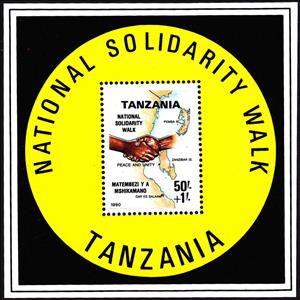Souvenir Sheet: Handshake across map (Tanzania 1990)
Handshake across map (Tanzania 1990)
06 July (Tanzania ) within release National Solidarity Walk 1990 goes into circulation Souvenir Sheet Handshake across map face value 50+1 Tanzanian shilingi
| Souvenir Sheet Handshake across map in catalogues | |
|---|---|
| Michel: | Mi: TZ BL117 |
| Stamp Number: | Sn: TZ B12 |
| Yvert et Tellier: | Yt: TZ BF124 |
| Stanley Gibbons: | Sg: TZ MS760 |
Souvenir Sheet is square format.
Also in the issue National Solidarity Walk 1990:
- Stamp - Handshake across map face value 50+1;
- Souvenir Sheet - Handshake across map face value 50+1;
Souvenir Sheet Handshake across map it reflects the thematic directions:
A hand is a prehensile, multi-fingered organ located at the end of the forearm or forelimb of primates such as humans, chimpanzees, monkeys, and lemurs. A few other vertebrates such as the koala (which has two opposable thumbs on each "hand" and fingerprints remarkably similar to human fingerprints) are often described as having "hands" instead of paws on their front limbs. The raccoon is usually described as having "hands" though opposable thumbs are lacking.
A map is a symbolic depiction emphasizing relationships between elements of some space, such as objects, regions, or themes. Many maps are static, fixed to paper or some other durable medium, while others are dynamic or interactive. Although most commonly used to depict geography, maps may represent any space, real or imagined, without regard to context or scale, such as in brain mapping, DNA mapping, or computer network topology mapping. The space being mapped may be two dimensional, such as the surface of the earth, three dimensional, such as the interior of the earth, or even more abstract spaces of any dimension, such as arise in modeling phenomena having many independent variables. Although the earliest maps known are of the heavens, geographic maps of territory have a very long tradition and exist from ancient times. The word "map" comes from the medieval Latin Mappa mundi, wherein mappa meant napkin or cloth and mundi the world. Thus, "map" became the shortened term referring to a two-dimensional representation of the surface of the world.


